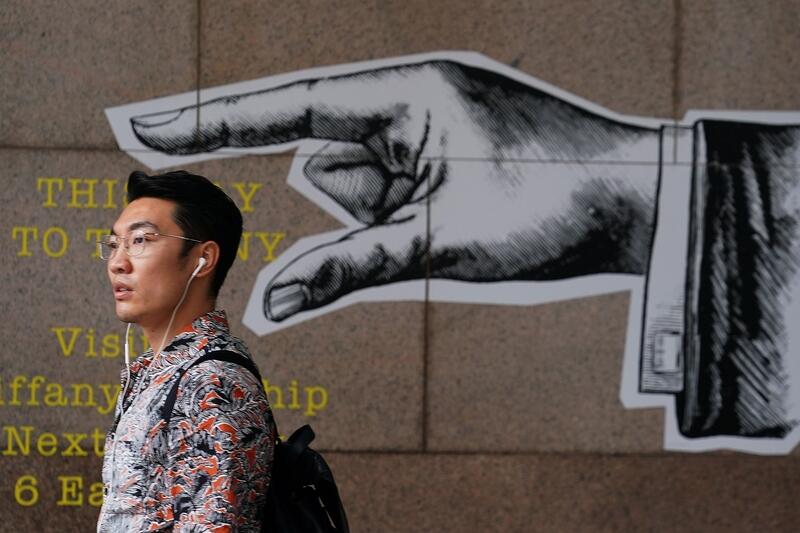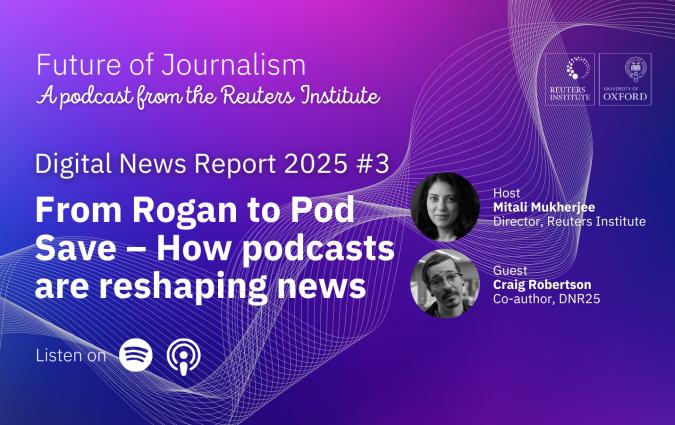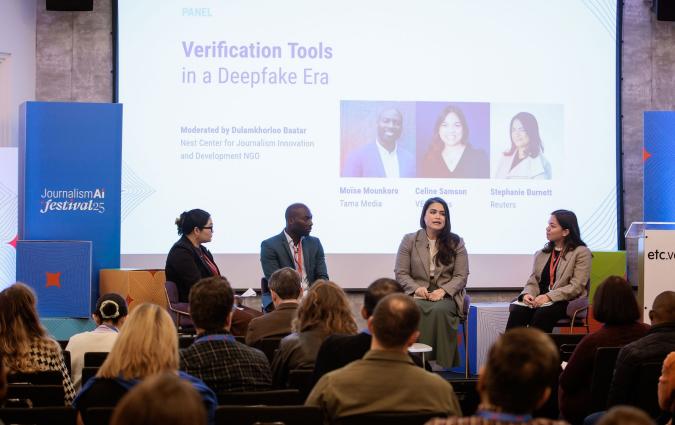Our podcast: the impact of COVID-19 on daily news podcasts

Man walking in Manhattan, New York City, September 2020. REUTERS/Carlo Allegri
The topic
Daily news podcasts are one of the most successful formats of media production and are amongst the most popular podcast genres. In the US they account for 1% of total podcasts but 10% of overall downloads, with similar listening trends elsewhere. With listening habits being driven in large part by the daily commute, we look at how changes to people's routines brought by COVID-19 have affected daily news podcasts, and how publishers are capitalising on audience desires to be updated on one of the biggest news stories of our time.
The guests
Our host is Federica Cherubini the Head of Leadership Development at the Reuters Institute. Our guest is Nic Newman, Senior Research Associate at the Reuters Institute and lead author of the report Daily news podcasts: building new habits in the shadow of coronavirus.
Listen to the podcast
On Spotify | On Apple Podcasts | On Google Podcasts
Transcript
On why news podcasts punch above their weight | On different formats | On 2020's news podcast boom | On what publishers should consider | On which platforms to publish on | On variations by country | On the impact of changing commuting routines | On COVID-19's impact on podcast formats
On why news podcasts punch above their weight ↑
Nic: There’s obviously a huge amount of interest in news right now, so that’s one reason. I think the other reason is to do with frequency. So these are new episodes that land in your feed every day, so they’re kind of constantly reminding you to listen. So many other podcasts historically have been maybe weekly or even monthly, and what we’ve seen over the last few years is the sort of frequency has got much greater, certainly this whole new format of news podcasts has emerged.
You know, news was never really a podcast thing because it was not considered – it was too timely, by the time you downloaded it it was out of date. But suddenly news podcasts really work and they’re really resonating with consumers. And what we found was, you know, [they are] 1% of the total production and in some countries up to 10% of the top episode listening, so that’s how much it’s punching above its weight.
On different formats ↑
Nic: So the 'deep dive', that’s sort of The Daily, the New York Times really popularised that, and when we talk to people, to publishers around the world who have used that format, they were all really inspired by it and studied it and sort of took it further. So typically that’s kind of 25 minutes, it’s the length of an average commute, and there’s examples like Please Explain, (Sydney Morning Herald), Today in Focus, (The Guardian). Genstart is a very successful, new, deep dive podcast from Danish Broadcasting.
But then you’ve also got the 'extended chat', so these can go on for 90 minutes or longer and it’s kind of slightly different, it’s kind of letting your hair down at the end of the day maybe. So Newscast from the BBC is an example of that, then you have sort of news roundups, this is really I guess people looking to very concisely tell people what’s happened. People sort of fit it in to their morning routines, so something like FT News Briefing or From the Newsroom from News.com in Australia would be an example.
And then finally you’ve got this sort of new segment of very, very short, what we’re calling ‘micro-bulletins’, and these provide again a very quick summary of the day’s news, they’re very much aimed at smart speakers, and new distribution from Spotify, My Daily Drive, is another way in which these very short bulletins are getting a lot of distribution.
On 2020's news podcast boom ↑
Nic: I think podcasts just generally is a really interesting area for many publishers, and I think a lot of it goes back to the audience profile. So what we see is that people who are listening to podcasts tend to be younger, they tend to be affluent, and this is really the audience that many publishers are chasing, particularly subscription publishers. So they see it, I think, primarily as a pipeline, as a way of starting that engagement journey, so that they might eventually become subscribers. The New York Times, for example, talks about this openly, it’s making money from the advertising side but then, in addition to that, it’s kind of engaging a whole new generation that it hopes will becomes subscribers.
So I think a lot of other publishers say the same thing, it’s also I think about the way in which these – in which audio is really able to engage people in deeper ways than digital media has traditionally been able to do. So you spend a very short amount of time on a website but you spend 25 minutes a day with a podcast like The Daily from the New York Times, and that is really, really valuable because ultimately, you know, that’s what advertisers want, they want engaged audiences and they want to be able to talk to those engaged audiences.
On what publishers should consider ↑
Nic: Well, I mean, I think the key thing is to sort of look at the market. If you look at the US right now it’s obviously very, very crowded, I mean, we documented 51 of these sort of native daily news podcasts. So if you’re going to launch a new one you have to have something to say that’s different and distinctive, because people have built up habits and they’re going to The Daily, for example, or to some of the other podcasts that have been around for a long time, and so it’s very hard to sort of switch out of that. So yeah, being really clear about why.
I think the other thing is the cost and the format. o what does the audience need that you’re satisfying? Are you trying to give people a quick update at the beginning of the day or are you trying to really showcase the best of your journalism? So being really clear about what type it is, going back to the four types we talked about, and then being disciplined about providing that format and that need every day. If it’s a news briefing, for example, you know, eight minutes, how can you really concisely give people something consistently every day that they’re going to come back for?
In terms of the cost, obviously you’ve got studios to think about, you’ve got hiring staff. If you’re going to the daily dive space you’ve got to think about some of the additional skills you might need around, for example, sound design, these are sort of new skills. If you’re going for a daily briefing it could probably be a bit more template. There will be different cost models you’ve got to bear in mind as well, and then finally you’ve got to think about the revenue; so are you going for advertising revenue, are you going for sponsorship, are you basically just using this as a marketing experience so that people really get to know your brand? There’s quite a lot to think about in all that.
On which platforms to publish ↑
Nic: This is again talking to publishers, you know, they’re very comfortable with producing content, but actually getting it out and hitting your audience is the tricky bit. I think traditionally it’s been about Apple, so most of the people who’ve been consuming podcasts have had Apple devices, because Apple put the podcast on the front of all of its devices and has been there since 2014, and it’s really only in the last few years that you’ve seen other sorts of distribution.
Google’s got really interested, both with its own podcast app but also now you can surface it through Search. The big mover has been Spotify. So in the last few years Spotify have invested hundreds of millions of dollars in podcast production, podcast distribution, algorithms, and that’s having a really significant impact now in many countries. In fact, in some of the countries you now have more people listening via Spotify than you do through Apple.
There are more ways to distribute your content, but there’s no substitute for having unique, distinctive content that engages people, and most people still basically listen to podcasts that other people tell them about. So, you know, the best recommendation is still word of mouth, amazingly so. It is up to the content and the value of that content, fundamentally.
On variations by country ↑
Nic: I think they’re really significant actually, and people, in our Digital News Report we see 30% of people in most countries now who say they’ve consumed podcasts over a month, but actually that hides enormous differences in terms of sophistication of the market. So I’ve already mentioned that there are 51 daily news podcasts in the US. Okay, it’s a big country, but it is an incredibly sophisticated industry now and the monetisation is really there now as well. So advertisers, because they saw the consumer demand is there and the range and quality of the podcasts is there, the advertisers have really piled in as well, so there are lots of opportunities to make money and find audiences.
In smaller markets, like Denmark, for example, or in even large markets like France, you’ve got a lot of people interested in podcasts, but the sort of business side hasn’t yet caught up, and so very few podcasts in small countries of Europe are really making making money, so that’s one difference. So you’ve got small markets on the one side and you’ve got very large markets, like the US, on the other side, and you’ve got a sort of sophistication on the advertising side and differences on the ad side too.
On the impact of changing commuting routines ↑
Nic: Well one of the things we know about news podcasts is they were specifically aimed at the commute, so they were aimed at, you know, your 25 minutes on the bus, on the train, in the car, and that’s where the majority of listening happened, so either on the morning commute or on the evening commute. So what happened? Well the commute, for many people, disappeared in lockdowns, and we have a chart in the report which shows what happened: you won’t be surprised, a complete flattening of the curve, essentially.
But what’s really interesting is, after an initial dip, the podcast audiences came back, they were just listening at different times. As you and I probably know all too well, there are many hours of the day, dead time, time when you’re doing other things, when you’re going for your daily walk, and podcasts are perfect for that as well. So what we’ve seen is people continuing to consume daily news podcasts because they really want to know about what’s happening, and particularly around coronavirus, but they’re just doing it in different places at different times of day.
So the curve has flattened, overall we found that consumption for news has grown and grown significantly for most of these publishers during that period, which has surprised many because people were really worried that the whole podcast boom would turn to bust as the commute disappeared.
On COVID-19's impact on podcast formats ↑
Nic: We obviously did see big changes in formats with sort of pop-up coronavirus output in many countries. You saw new podcasts specifically looking at coronavirus of all kinds of different lengths and different formats, you saw some very, very long ones indeed, you saw some like a coronavirus BBC podcast that then went on to television. So actually there was a lot of innovation in terms of how people thought about the story, about length, you saw some daily news podcasts becoming coronavirus podcasts and dropping other elements. I think this has definitely made people think much more about what people really need at particular times of day.
The big question is, are we going to go back to the old habits? You know, if we get the vaccine let’s hope, more people will be going back to the office, maybe not as much as before, and so one would expect those peaks to return. But interestingly we are still seeing morning peaks, so people still have that sort of core audience need to brief themselves at the beginning of the day whether they’re at home or in the office.






